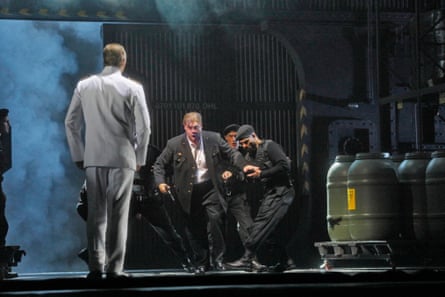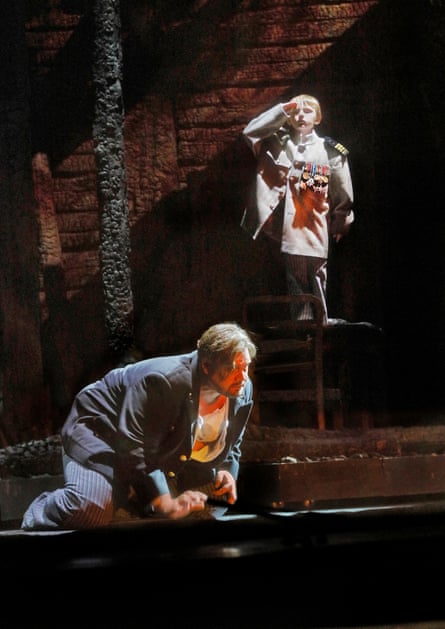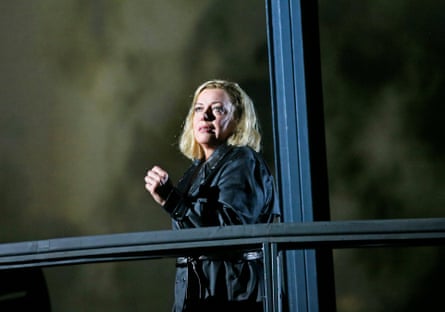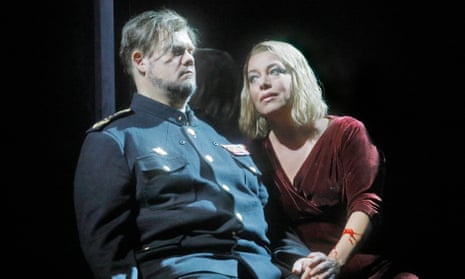Tristan und Isolde, we are often told, is one of the truest measures of a grand opera company’s resources. It takes a formidable orchestra, a visionary conductor, a hardy cast of supple singers. Less frequently itemized in this array of requirements is a director possessed of useful ideas – but that’s also important, as the Metropolitan Opera’s strange new misfire of a production makes clear.
This season in New York, we have soprano Nina Stemme giving a high-powered, gorgeous account of Isolde – and some ravishing Wagnerian orchestral sweep driven by conductor Sir Simon Rattle. Both of those musicians are too infrequently heard here. Unfortunately, they are laboring in and around a concept by director Mariusz Treliński that isn’t anywhere close to their mutual level of artistry. Judged by the ear, Monday’s premiere was a marvel. By the eye, it was a nearly five-hour parade of unforced errors.
Directorial license in the world of opera takes place between two poles of extremity. One one side, there is the lighter touch. This less-controversial style involves activist moves that nevertheless seek to harmonize in some way with opera as it has been historically understood. These directorial interventions might include putting the action in a new century, using modern dress, or adding some “framing device” – not in the interest of revising the drama, but rather to make its poetry more readily approachable in the moment. The opposing approach might be called the “rewrite” style, wherein the historical intention of the work holds no particular authority, and can thus be stretched, tortured or abandoned at will.

The overdetermined darkness and cynicism of this production falls in the latter bucket. For those who won’t brook any form of directorial liberty-taking, that will be enough to dismiss it. But as someone who has been persuaded by aggressive rethinks at other times, I think it’s important to describe why Treliński’s would-be radical approach seems so poorly conceived.
The first ill omen was the opening prelude, during which the music was pushed from its usual starring role into one of accompaniment – a mere backdrop to a visual pattern of a modern warship’s radar signal, rotating clockwise (over and over).
This image impressed, at first, as simply pedestrian and ugly. With its insistent presence over the ensuing three acts, the visual tic did not manage to endear itself. Yet it was just the opening gambit in Treliński’s fruitless straining for gothic urgency. Other video motifs introduced during the first act prelude included a lunar eclipse-like black orb that floated among barren trees in a dark wood. There were also glimpses of a spectral figure in a military outfit. (Alternately, he was gripping a gun, or else a head of a child, close to his chest.) We saw a humble wood-plank abode dissolving into fire and ash.
None of Treliński’s iconography was in a hurry to make itself coherent, in relation to the story of Tristan und Isolde. In fact, the director primed the audience to misread some of his preferred visual cues, for hours. (Elements from that opening montage also introduced the subsequent two acts, just to make extra certain that every viewer would remember to ponder them.) When the brilliant bass René Pape entered as King Marke, his crisp white military outfit seemed to recall the suicidal figure in Treliński’s opening video sequence. But that also made no literal dramatic sense, since in the libretto it’s clear that he has no children. (Also: King Marke wouldn’t live in a wooden shack.) Unless the child he’s gripping close is the fate of his nation? And the burning house a symbol of … something?

If this all seems far removed from the world of thought and emotion typically inspired by a good performance of Tristan und Isolde – well, yes. Finally, in the third act, when Tristan is laid up from a mortal wound and raving in the absence of Isolde, Treliński allows us the interpretive key to his imagery. As Tristan recalls learning of his father’s premature death, the director has a physical replica of the video-depicted, burned-up house wheeled on to the stage. Tristan gambols through the ashes of memory, uncovering his father’s sullied uniform. So it was Tristan who was the child in all those videos. In Treliński’s version, he watches his father commit suicide, rather than learning of the death via a mournful melody that Wagner’s score and libretto present in more poetic detail.
That the director prefers to make his own pictures take precedence over the sounds and words of the opera is, in itself, notable. More important – and more quizzical – is the fact that director has elected to make an opera-wide fetish out of such a minor point in the work. The great length we have to travel for a reveal of such jaw-dropping inconsequence is just one mark of how turgid and unrewarding this staging can feel.
Another major problem with this vision of the opera is the demotion of Isolde that it enforces by necessity. By trapping Tristan so completely within an unresolved daddy drama from childhood, the opera’s more adult-oriented obsessions with death and carnal longing (and their mixture) is severely blunted. Accordingly, tenor Stuart Skelton’s honey-voiced portrayal of Tristan doesn’t have much in the way of chemistry with Stemme’s Isolde. At first, I thought this a deficit in Skelton’s acting. By the third act, the production’s overall hostility to the erotic was more clearly to blame. In the end, Skelton was reduced to being propped up like a lifesize stuffed animal – blank and expressionless, in death as in life – while Isolde slashed her wrist and sang the Liebestod. (Marvelously, for all that mattered.)

It’s not that there’s nothing to new to say about Tristan und Isolde. It might be possible for a production to offer a point of contrast with the romance that is undeniably there in the music (despite its famous chromaticism and general adventurism). I can imagine a world in which a director might make some kind of interesting point about the contradictions that are inherent in the pursuit of love during wartime. Or a staging that engages philosophically with the fact that the lovers’ fevered affections are inspired by a potion, in the first instance. But Treliński’s cynical take doesn’t have anything detailed to offer, save for a juvenile rejection of the work’s charms. There’s no synthetic argumentation, just a stark refusal to do justice to the balance of light and dark that is present in the opera.
That Stemme gave such a lustrous and controlled reading of all her act three music seemed like a sort of implicit protest against the cheap grimness of this production. Upon encountering her already dead Tristan, she asks whether she will be denied a chance to at least luxuriate for another hour in the problems they faced together (“Nicht meine Klagen darf ich dir sagen?”).
It might as well have been a question posed to Stemme’s director – the same artist who, in act two, set the lovers’ exultation on a portion of the ship that looked like an early George Lucas sketch for a Death Star observation deck, and who staged another rendezvous in a cavern of the vessel otherwise dedicated to storing chemical refuse. (There were audible laughs in the audience when one of the chemical drums was knocked over and hit the stage with the sound of an oversized dodgeball falling to the floor in an elementary school gym.) Rattle worked with Treliński where he could, building to some climaxes with a halting, noir-like approach – whereas James Levine might have privileged a greater sense of flow. But at other junctures, Rattle departed from the tenor of the staging and let the music sing the way its composer intended.
The opening night audience was not confused about what worked and what did not. The singers, who ranged from good to great, received commensurate ovations. Pape got a big one – which he’d earned by imparting a real sense of injury and emotional stakes during his features. Mezzo-soprano Ekaterina Gubanova started out a bit underpowered in the role of Brangäne – but by the time of her more fervent debates with Isolde, the singer held her own alongside Stemme’s force-of-nature voice. Rattle and Stemme were both duly appreciated.
Upon their curtain call, the production team inspired a blend of less-forceful applause and some hearty booing. Voices of disapproval at the premiere of a new production aren’t new, of course. Nor are they always correct. In the past, I’ve encouraged Met patrons to give chancy stagings an honest try. Last season, I enjoyed Treliński’s sly presentation of Tchaikovsky’s Iolanta alongside Bartok’s Bluebeard’s Castle. But his Tristan amounts to a feverish squandering of elite operatic resources.

Comments (…)
Sign in or create your Guardian account to join the discussion